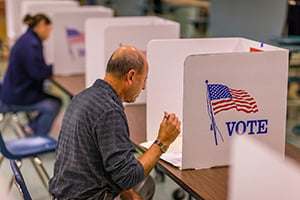 “It will take as long as it takes,” a reported quote from the Pennsylvania attorney general about the vote count, can also apply to the election itself. Indeed, from where we stand right now, the Pennsylvania vote count will determine the election. We don’t know what the final answer is, and we don’t know when we will know. So, are we any further along than yesterday?
“It will take as long as it takes,” a reported quote from the Pennsylvania attorney general about the vote count, can also apply to the election itself. Indeed, from where we stand right now, the Pennsylvania vote count will determine the election. We don’t know what the final answer is, and we don’t know when we will know. So, are we any further along than yesterday?
Despite the fact that the White House still hangs in the balance, we do in fact know quite a bit more than we did yesterday. Let’s start with the good news.
The Election Went Smoothly
There were no significant breakdowns in the voting process, no material reported issues of voter suppression, and, perhaps most important, no significant violence. For all the fears and headlines, we got through Election Day without things breaking down. This is a big win and radically reduces the uncertainty around the election going forward.
The Process Is Working
All parties involved are now working to count the remaining votes and determine the legitimate winner. Again, with fears about election interference (both domestic and foreign) and charges (on both sides) that the election would be stolen, it is good to see the process working as it should. There will no doubt be litigation going forward. But the point is that litigation is an essential part of America, and it isn’t street fighting. Watching the process work is proof that the process is working, and many people were not sure of that outcome last week.
Markets Reacting Positively
Markets are reacting very positively to the fact that a great deal of the election uncertainty has passed. Not all of it, but at least the worst outcomes seem to have been avoided. Markets hate uncertainty, and this is likely to be a tailwind for a while.
What Comes Next?
We can also draw some preliminary conclusions about the likely path of policy, although mostly about what will not happen. With no blue wave, we are likely to see the Senate remain very closely divided, which will constrain the policy options of whoever wins the presidency. That probably rules out any substantial activity on taxes, as well as limiting any actions to control the major tech firms. On the positive side, once the election is resolved, the political order will be set, and items such as fiscal stimulus can be negotiated. Again, the story here is that uncertainty is down significantly and will drop further once we get the final figures.
We might still see the election disputed, of course. But the real takeaway today is that the most damaging outcomes are now pretty much off the table. From a policy perspective, we see the same thing, with most of the policy outcomes that investors would be most affected by (e.g., higher taxes or regulations) now significantly less likely. While there are still things to worry about, as citizens and investors, we are in a much better place than we might have been—and than we feared we would be. Something to celebrate while we wait for the final results.


 Print
Print

